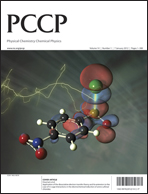Benchmarking DFT Approximations for studying Apatites
IF 2.9
3区 化学
Q3 CHEMISTRY, PHYSICAL
引用次数: 0
Abstract
Despite the growing interest in apatites, available experimental studies on their properties are limited in scope. Researchers, therefore, are increasingly resorting to predictions using the density functional theory (DFT). However, large deviations can be seen between DFT based estimates and experimental results, presumably due to approximations made in DFT models. We undertake a comprehensive benchmarking exercise involving sixteen exchange-correlation (XC) functionals (including dispersion corrections), five pseudopotentials (PPs), and two basis sets to unravel their best combination for studying apatites. The comparison involves lattice parameters, elastic constants, bulk modulus, and band gap of three specific apatites -- hydroxyapatite, fluorapatite and chlorapatite. We show, quite reassuringly, a weak sensitivity of the properties to the choice of PP and the basis. The XC approximation and/or the inclusion of the dispersion corrections has significant influence on the accuracy of predicted properties. The underlying reasons behind different XC functionals providing different properties are identified. Our recommendation is to use dispersion corrections in XC functionals for studying apatites but with some caution. Overall, the optB86b-vdW functional provides the best accuracy when compared to the available experimental results.为研究磷灰石的 DFT 近似方法制定基准
尽管人们对磷灰石的兴趣与日俱增,但有关其特性的现有实验研究却范围有限。因此,研究人员越来越多地采用密度泛函理论(DFT)进行预测。然而,基于 DFT 的估计值与实验结果之间存在很大偏差,这可能是由于 DFT 模型中的近似值造成的。我们进行了一项全面的基准测试,涉及十六个交换相关 (XC) 函数(包括色散修正)、五个伪势 (PP) 和两个基集,以揭示它们在研究磷灰石时的最佳组合。比较涉及三种特定磷灰石(羟基磷灰石、氟磷灰石和氯磷灰石)的晶格参数、弹性常数、体模量和带隙。令人欣慰的是,我们发现这些特性对 PP 的选择和基础的敏感性很弱。XC 近似值和/或包含色散修正对预测性质的准确性有重大影响。我们找出了不同 XC 函数提供不同性质的根本原因。我们建议在研究磷灰石时使用 XC 函数中的色散修正,但要谨慎。总体而言,与现有的实验结果相比,optB86b-vdW 函数提供了最佳精度。
本文章由计算机程序翻译,如有差异,请以英文原文为准。
求助全文
约1分钟内获得全文
求助全文
来源期刊

Physical Chemistry Chemical Physics
化学-物理:原子、分子和化学物理
CiteScore
5.50
自引率
9.10%
发文量
2675
审稿时长
2.0 months
期刊介绍:
Physical Chemistry Chemical Physics (PCCP) is an international journal co-owned by 19 physical chemistry and physics societies from around the world. This journal publishes original, cutting-edge research in physical chemistry, chemical physics and biophysical chemistry. To be suitable for publication in PCCP, articles must include significant innovation and/or insight into physical chemistry; this is the most important criterion that reviewers and Editors will judge against when evaluating submissions.
The journal has a broad scope and welcomes contributions spanning experiment, theory, computation and data science. Topical coverage includes spectroscopy, dynamics, kinetics, statistical mechanics, thermodynamics, electrochemistry, catalysis, surface science, quantum mechanics, quantum computing and machine learning. Interdisciplinary research areas such as polymers and soft matter, materials, nanoscience, energy, surfaces/interfaces, and biophysical chemistry are welcomed if they demonstrate significant innovation and/or insight into physical chemistry. Joined experimental/theoretical studies are particularly appreciated when complementary and based on up-to-date approaches.
 求助内容:
求助内容: 应助结果提醒方式:
应助结果提醒方式:


